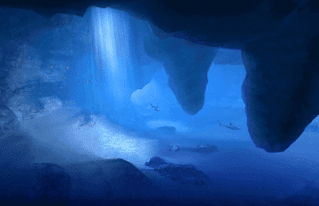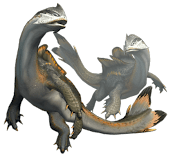Monster Hunter Tri Review: A tri-umph
NOTE: The images used in this article are promotional pieces from the developer.
TheLagiacrus (a sea monster) is disrupting sea life, wrecking ships, and generally making life difficult for a small island fishing village. The protagonist is the island's only Monster Hunter (in training) and defense against the ornery wildlife. They will need to build their own gear, scout the island, and eventually bring down the troublesome Lagiacrus.
I enjoyed the tiny community and middle of nowhere, backwater setting.
Monster Hunter is a fantasy hunting series that relies on the raw stats of gear, coupled with player skill and perseverance to bring down massive monsters. The early games are known for being quite punishing, but the difficulty curve in Tri isn't as tough as Dark Souls. However, a lack of focus and determination will end swiftly in failure. The player has a set amount of health and stamina that does not change throughout the game, although, it can be boosted temporarily with food and potions. The player's gear is what really matters. It determines damage output, defense, active abilities, elemental strengths and weaknesses - everything stat wise about the player character. For those individuals dedicated enough, there are formulas and apps for calculating the best weapon and armor builds. Tri's formula for weapon damage:
(ATK x MV x Sharp x Hitzone) + (Element x Sharp x Elmzone / 10) = Total Damage
- ATK - Raw weapon damage.
- MV - Motion value. The slower the animation the more damage.
- Sharp - The sharpness of the blade (a value of .50 to 1.50).
- Hitzone - Damage for where the monster was hit (different body parts are effected differently).
- Element - The raw elemental damage of a weapon (if any)
- Elmzone - Elemental damage for where the monster was hit (different body parts are effected differently).
There is also an Affinity stat, the probability of doing critical damage, expressed as a percentage ranging from -100% to +100%. Strong hits (positive Affinity) do 25% more damage and weak hits (negative Affinity) do 25% less. There are instances where negative affinity can actually do more damage than positive affinity, but I'm not going to get into that here. The formula for calculating Affinity:
(ATK) x 1 + (.25 x Affinity) = Average Damage
There are seven weapons to choose from: Greatsword, Sword & Shield, Hammer, Lance, Switch Axe, Long Sword, or Bowgun (the only ranged weapon) and the type of weapon being used will greatly impact play style. The Greatsword for example, has the highest damage output but is slow and heavy, impacting how quickly the player can move or draw the weapon. It dulls fast, making it an impractical weapon for monsters with an especially tough hide. The hammer's blunt damage on the other-hand, is amazing for making the armored monsters see stars. Each hit (other than on the head) will drain the monster's stamina, putting a stop to its more dangerous attacks by exhausting it. But without cutting damage it becomes impossible to sever tails.
The core gameplay loop of the Monster Hunter franchise is simple: kill beasts, craft gear with their skins, kill even bigger beasts, craft better gear, repeat. The player will need to master their chosen weapon's abilities and take full advantage of a monster's openings to succeed. Every beast has a tell or windup to their attacks. These tells are easy to spot early on but become shorter and less broadcasted with the late game monsters. Anticipating these attacks and dodging or striking at the right moment is key to avoiding raw damage and status ailments. A mission will fail if the player faints three times or runs out of time - usually 50mins.
Tri is the first, and to this day the only, Monster Hunter game to feature underwater battles. To take advantage of this new mechanic, all of the boss monsters in Tri, with the exception of Rathian and Rathalos, are new to the series. Most of the aquatic monsters have since appeared in future game releases with altered combat moves to accommodate battles on land. Although, there is a good chance the Gobul and Epioth may never appear in future games due to how heavily they relied on the existence of water. And while aquatic combat opened up some fun monster design possibilities, it also created one of the franchise's most divisive environments. Some love the uniqueness and fluidity of swimming. Others hate the lack of camera control (hardware specific) and limited maneuverability. I have mixed feelings. I look back at the water combat as a unique experience in the series and as something intrinsically tied to Tri's identity, but ultimately unnecessary. Underwater combat didn't add depth or use the environment in clever ways. With the exception of Gobul, most of the attacks were just the standard bellyflop/hipcheck/tailswip. Three dimensional movement wasn't special either because the flying monsters can do the same. The player had to manage oxygen levels and deal with stunted mobility while the monsters got a home field advantage. I never beat the near fully aquatic flagship monster Lagiacrus in Tri, but I beat him down with ease in future titles.
Caves are pitch black and require a torch. The player has to drop the torch to mine.
Moga village (hub area) is where the player character resides until a mission is accepted - either an open-ended mission (no goal or timer) or a timed mission in one of five distinct biomes. The player can take a limited number of provisions with them, anything from nutrients to boost the health gauge, food to extend the stamina bar, whetstones for sharpening blades, cold/hot drinks for the desert/tundra, attack and defense boosters, bug nets and pickaxes for resource gathering, et cetera, et cetera. The map itself is made up of several small interconnected areas linked together by loading screens, and it is not uncommon to spend the first few minutes jumping between areas in search of the target monster, which is not tracked on the map until the player hits it with a paintball - a provision you must make in the field or bring along.
Four areas of the same map. They are varied and interesting.
The core gameplay loop is fun, if a bit repetitive. A lot of time is dedicated to collecting a large range of natural resources, crafting your own items, and carving up the same monsters at least four times to get a single piece of armor. And for some arbitrary reason, melee and ranged weapons can't use the same armor sets. I also never understood what the purpose of drugged meat was. The monsters never touch it and I can't eat it.
Monster Hunter Tri isn't the best title for someone looking to get into the Monster Hunter franchise, its tougher than newer entries, and lacking a lot of the gameplay innovations and streamlining of the latest releases. However, it is still a very fun entry in the series. The beasts are colorful and diverse, ranging from eyeless cave dwellers to narcolepsy inducing ice lizards. The hunts are a thrill, if a bit monotonous, especially after extended play. There is a learning curve to the game's mechanics that requires some dedication to over come, but the game does a fairly good job of easing the player into all of its systems. And for better or worse, the water segments offer a hunting experience not found in any other Monster Hunter game.
This review is based on the original Wii release, using a classic controller pro. Monster Hunter Tri G and Monster Hunter 3 Ultimate are upgraded versions of the original with more monsters and gear.
First posted to videogamegeek.com on March 1, 2020.

















Comments
Post a Comment